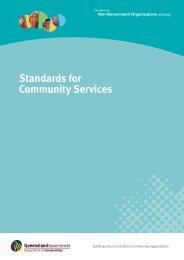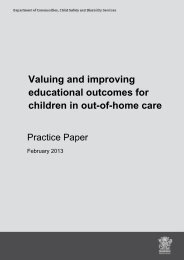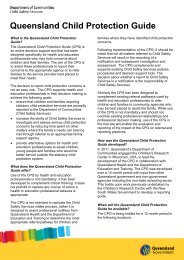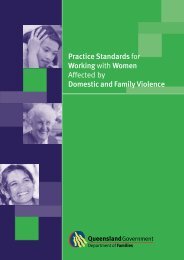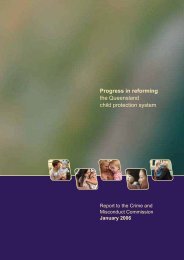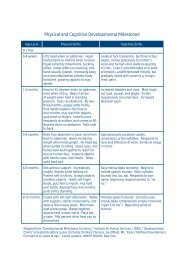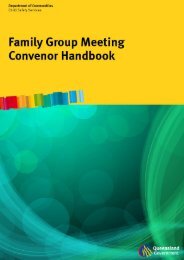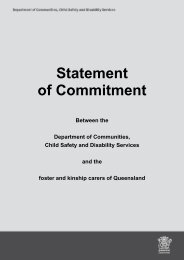Housing and Support Program (HASP): Final Evaluation Report
Housing and Support Program (HASP): Final Evaluation Report
Housing and Support Program (HASP): Final Evaluation Report
You also want an ePaper? Increase the reach of your titles
YUMPU automatically turns print PDFs into web optimized ePapers that Google loves.
56<br />
Section 6<br />
The ability of the program to maintain clinical functioning <strong>and</strong> provide<br />
an acceptable quality of life for those supported by the program<br />
This section of the report explores factors related to clinical functioning <strong>and</strong> how these<br />
are maintained under <strong>HASP</strong>. Factors such as changes in clinical functioning, medication use,<br />
physical health, client goals, participation in meaningful activities, employment, level of<br />
independence <strong>and</strong> the need for inpatient care are discussed.<br />
6.1 Readmissions to acute<br />
inpatient care<br />
The need for readmission to acute care is one indicator<br />
of how well a program can maintain clinical functioning<br />
in individuals with high levels of disability. Of the<br />
80 clients in our sample, admission data (number<br />
of admissions <strong>and</strong> length of stay) were available for<br />
70 clients at 12 months prior to entering <strong>HASP</strong> <strong>and</strong><br />
12 months post-entry into <strong>HASP</strong>. While 61 of the<br />
70 clients for which data were available (87.1%)<br />
required time in hospital in the 12 months prior to<br />
<strong>HASP</strong>, 41 of these clients spent the entire 12 months<br />
in hospital prior to entry into <strong>HASP</strong>. However, following<br />
entry into <strong>HASP</strong>, only 26 clients (37.1%) required time<br />
in hospital in the 12 months post-<strong>HASP</strong>.<br />
The average time in inpatient care for each individual<br />
in the 12 months prior to <strong>HASP</strong> decreased signifi cantly<br />
from an average of 227 days to an average of<br />
18.9 days in the 12 months post-<strong>HASP</strong>. This reduction<br />
in inpatient bed days was statistically signifi cant<br />
(paired t = 10.44, p=0.001). <strong>Final</strong>ly, the number of<br />
admissions also decreased signifi cantly from an<br />
average of 1.22 admissions in the 12 months prior to<br />
<strong>HASP</strong>, to an average of .66 admissions per individual<br />
in the 12 months post-<strong>HASP</strong> (paired t = 3.22,<br />
p=0.002).<br />
<strong>Final</strong> <strong>Evaluation</strong> <strong>Report</strong><br />
6.2 Changes in functioning<br />
As noted earlier, ‘outcomes’ data were obtained from<br />
the Queensl<strong>and</strong> Health Information System ‘CIMHA’<br />
for the 77 clients who provided written consent for<br />
their data to be used for the evaluation. (Three clients<br />
refused to provide consent for their outcomes data<br />
to be used in this way). Having identifi ed the date<br />
that each individual entered <strong>HASP</strong>, it was possible to<br />
obtain the outcomes data from CIMHA for clients at 12<br />
months <strong>and</strong> three months prior to entering <strong>HASP</strong> <strong>and</strong><br />
for three months <strong>and</strong> 12 months after entering <strong>HASP</strong>.<br />
The mean scores for the both the Life Skills Profi le<br />
(LSP) <strong>and</strong> the Health of the Nation Outcome Scales<br />
(HoNOS) are summarised in the graph below. The LSP<br />
provides a measure of general life skills functioning,<br />
while the HoNOS provides an assessment of disability<br />
<strong>and</strong> clinical functioning. There was a considerable<br />
amount of missing data for the 77 clients. HoNOS data<br />
were available for 33 of the 77 clients across all four<br />
time-points, while LSP data were available for 17 of the<br />
77 clients across all four time-points.<br />
Fig. 6.1 Changes in functioning<br />
Score<br />
20<br />
15<br />
10<br />
5<br />
0<br />
Legend<br />
HoNOS (n=33)<br />
12<br />
months<br />
pre<br />
3<br />
months<br />
pre<br />
LSP (n=17)<br />
3<br />
months<br />
post<br />
12<br />
months<br />
post<br />
Overall, the clients, as a group, demonstrated<br />
improvement in functioning as indicated by the lower<br />
mean scores (lower scores on these scales indicate



